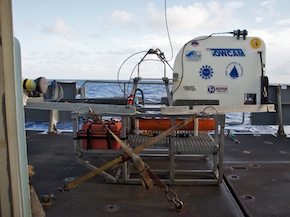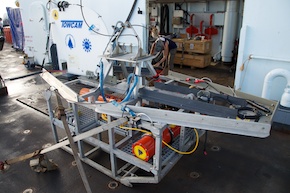The R/V Thomas G. Thompson left Honolulu on November 5, 2011 heading toward the Western Pacific. This expedition journal was written by cruise participants and uploaded about once per weekday, depending on internet availability.
November 11, 2011: TowCam Ops

TowCam, one view (Credit: Will Koeppen)
The TowCam sled is an instrumental asset for our geophysical research that has a wide spectrum of uses. It is a heavy, durable frame with two shelves that allow many different pieces of equipment to be attached. The top shelf has a hard polymer fin installed to assist in keeping the sled "swimming" straight when it’s being dragged behind the ship. For this expedition, the sled is outfitted with two different types of magnetometers, one that measures the strength of the magnetic field while the other measures its direction. Although it’s called the TowCam, in our configuration we replaced its small camera with the second magnetometer.
Once we complete the first round of seismic surveying, the TowCam will be deployed from the starboard (right) side of the ship and used in tandem with the AUV-Sentry. TowCam deployment requires four personnel — one winch operator, one boom operator, and two people anchoring from each side. The winch and boom operators coordinate to bring the TowCam off the deck. Meanwhile, the anchors stabilize it so it doesn’t rotate. The operators then lower the TowCam over the starboard side of the ship into the water. All four people are required to maintain complete control over the TowCam to ensure no damage is done either to TowCam, the hull of the ship or personnel on deck.

TowCam, another view (Credit: Will Koeppen)
Once TowCam is deployed, it is utilized mainly as a mid-depth magnetometer array in order to provide a magnetics survey that is complimentary to that of Sentry. We achieve this by paying out enough cable so that it reaches a depth of ~2500 meters. TowCam also serves as an important intermediate re-transmitter, allowing us to better locate Sentry when it is at depths of 6000 meters. As TowCam’s round ends, it will slowly be brought to the surface where six personnel await the arrival of "Volkswagon Bus," aptly named by our very own chief scientist. During the recovery, two personnel use long poles with detachable metal clip hooks to attach lines to the sled. As each hook is firmly clipped into the eyelets, the anchors hold onto the line and give a firm pull on the poles, which are passed off and secured in the holding bay. The winch operator and boom operator then coordinate with one another once again, while the anchors keep TowCam from turning into a spin, to bring TowCam back over the rails and carefully back to rest on the deck in order to readied for the next science cycle.
It sounds like a simple process. However, the ocean doesn’t like to play fair and can cause some excitement and frustration during deck operations. For example, when I helped retrieve the TowCam during testing, the waves and roll of the boat caused TowCam to turn away from the hooks seeking to capture the frame. During testing, we also discovered the hooks were a bit too big for TowCam’s eyelets, compounding the issues involved with getting it back on the ship. We are now revising our technique, and this is where the old adage "practice makes perfect" comes into play. ♦
